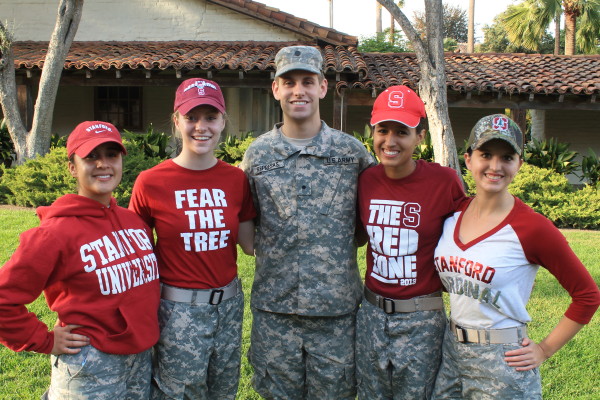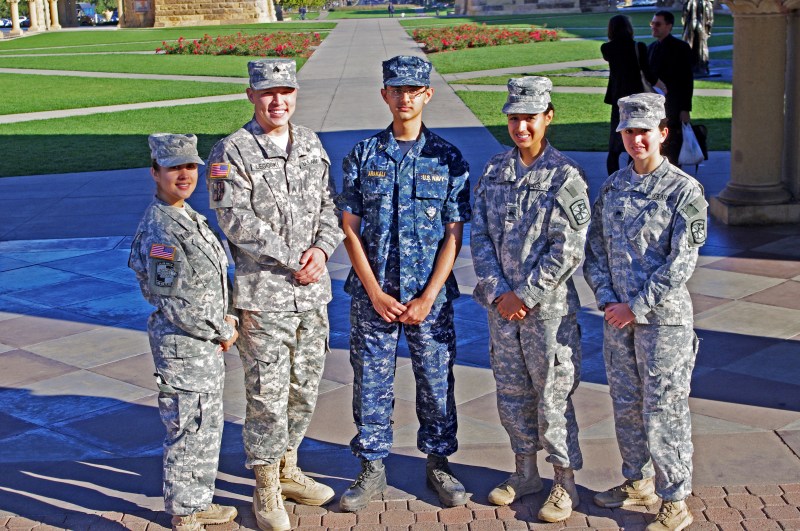Two and a half years after the Faculty Senate invited the Reserve Officers’ Training Corps (ROTC) back to campus in a contentious vote, not much has changed in the daily lives of ROTC students at Stanford. Cadets still have to travel to surrounding campuses for the majority of their training, but they are now able to receive activity and academic credits for their ROTC coursework.

For ROTC cadet Isabel Lopez ’14, the recognition from the University has helped her feel more supported on campus.
“Having the units is nice, but given that there’s a lot of ignorance on campus about the military and ROTC, it’s nice to feel that someone is genuinely interested and cares to help us out,” Lopez said. “Not that there’s anything bad that happens, but it’s just nice to be recognized like that.”
The ROTC was formally invited back to campus in April 2011 after more than a year of contentious discussion during which competing petitions circulated, Condoleezza Rice and George Shultz weighed in and an ad hoc committee was formed to explore the issue.
Much of the controversy involved the ban against transgender people serving in the military as well as the limits that the ROTC can put on academic exploration. In a statement released following the Faculty Senate’s vote, President John Hennessy and Provost John Etchemendy Ph.D. ‘>82 wrote that they understood the concerns of discrimination, “but if the leadership of the military is drawn from communities that teach and practice true tolerance, change is more likely to occur.”
Even before the vote, however, Stanford had a relationship with the ROTC branches as students participated in the program through other schools — either Santa Clara University, San Jose State University or Berkeley, depending on the service branch.
Because a full ROTC branch has still not been established at Stanford, the nine current ROTC cadets have to commute for much of their training.
Scott Calvert, senior administrator in the Office of the Vice Provost for Undergraduate Education and retired Navy officer, said that because of budget cuts, the Department of Defense is not currently looking to expand its capacity and add ROTC branches.
“So, we kind of went to a plan B,” Calvert explained, “and here’s the thing that changed: The other part was to recognize the work that ROTC students were doing and to give credit.”
As of the 2012-13 school year, cadets are able to receive one unit of activity credit each quarter and two units of academic credit for each ROTC course taken during their sophomore, junior and senior years, but only with a grade of Credit/No Credit. Cadets can apply these units towards graduation under the same guidelines as the general undergraduate population.
“I wish I got academic credit — it would boost my GPA,” Lopez said. “It’s not like they’re joke classes. There are comparable classes at Stanford.”
The Army branch ROTC has also established an office in Sweet Hall, which acts as home base for a handful of cadre affiliated with the Stanford military community. These captains teach a first-year military science course on campus, and more broadly serve as the point persons for any ROTC-related student questions or concerns. The office is useful, but “a very underutilized resource,” according to Lopez. The other ROTC branches do not have offices on campus.
“Even for the Army ROTC program, we are trying to rebuild the program back at Stanford, and we are actually providing more army cadre there just to cover in the office hours during the week,” said Army ROTC enrollment officer Mario Morales. “But it’s still kind of a work in progress.”
Despite the controversy surrounding the vote, ROTC students said that the University has been supportive as they work to rebuild the program, which included approximately half the male student population in its World War II heyday.
According to Lopez, the Haas Center pays for the ROTC cadets’ commute as part of the Military Service as Public Service project. Started in 2010, the initiative takes care of ZipCar costs for the group’s trips to and from their training locations, as well as other activities for the military students, including community-building events and featured speaker sessions.
ROTC students are still hoping to improve several policies. While the units have helped cadets stay on track to graduate, Stanford’s unit cap can make scheduling difficult.
“We have three mandatory ROTC units, and the maximum [for one quarter] at Stanford is only 22 units,” explained ROTC cadet Lauren McCune ’15. “That makes it impossible for us to take four five-unit classes. I tried for about a year to change that, but kept getting a flat-out no.”
ROTC students also don’t get access to the benefits available to student-athletes, despite the physical nature of their training.
“We are like athletes, but we don’t get massage therapists, or extra help and tutoring,” said Kaitlyn Benitez-Strine ’15, another Army cadet. “I wish we got that. I might push for that.”
According to Joshua Schott ’14, however, that is how it should be.
“I think the military should provide the proper physical therapy resources to cadets,” said Schott, former president of Stanford Says No to War, one of campus’ prominent voices against the ROTC’s return. “That shouldn’t be the University’s responsibility and considering that the military budget comprises half of the federal budget…the military should be able to care for the physical health of its cadets.”
Morales said that as the ROTC works to rebuild its presence at Stanford, it hopes to add more on-campus programming.
“You know, there will always be people that don’t care for the military, don’t want to have anything to do with the military because of what it represents, and that’s fine,” Morales said. “But there are definitely other students who are interested in the military and do want to understand what the program is about, and that’s what we’re there for.”
Contact Dania Marinshaw at daniam ‘at’ stanford.edu.
